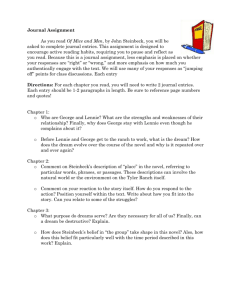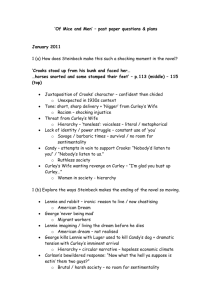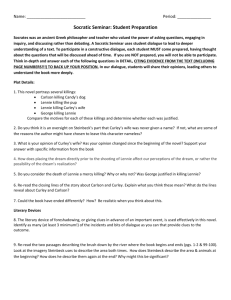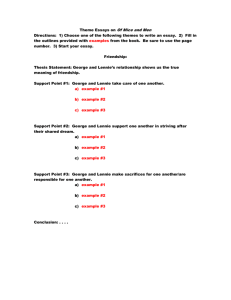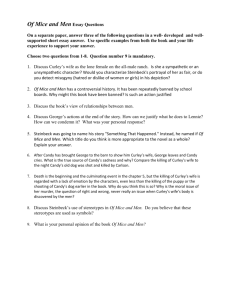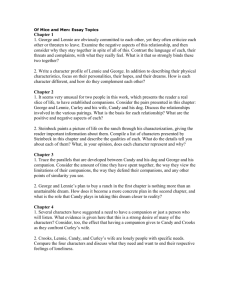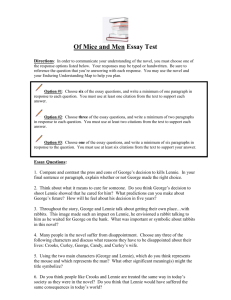Miss K`s
advertisement
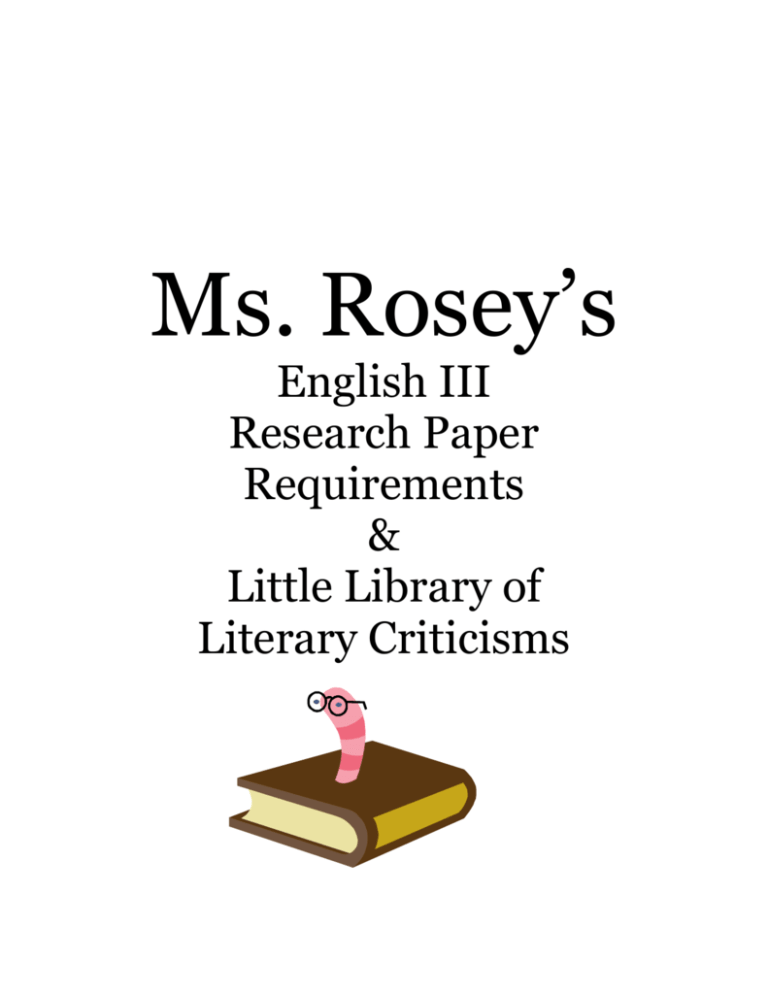
Ms. Rosey’s English III Research Paper Requirements & Little Library of Literary Criticisms Research Paper Information Okay! It is time for the most important thing you are going to write in my class! This year, your research paper will be a Literary Analysis on Of Mice and Men. What is Literary Analysis? A literary analysis essay presents a thesis about the text supported by close analysis of its language and structure; it aims to illuminate the text in such a way as to accomplish one or more of the following goals: to help the reader of the paper to better understand and/or better appreciate the work discussed to uncover weaknesses in the work to reveal or help explain the work's strengths to provide a fresh perspective on the author's literary methods, cultural significance, and political or spiritual or aesthetic goals to explore the significance or meaning of a work for a particular audience or within a particular context. Literary analysis discusses the literary work as such, considering how the writer has handled a particular subject or theme rather than simply discussing the subject or theme itself. You will also include references to the THREE Literary Criticisms that you have chosen. Simply said, YOU take the main point that you are trying to prove (your thesis) and SUPPORT your main point with samples from the work (Of Mice and Men) and the literary criticisms you have found. IDEAS FOR WRITING -Character analysis of George or Lennie -Analysis of George and Lennie’s friendship -Analysis of minor characters, such as Curley, Curley’s wife, Candy, Slim, Carlson, or Crooks -Analysis of theme, such as: -Searching for the American Dream -Idealism vs. Reality -Class Conflict -Race and racism -The Need to Belong -Loneliness and Alienation -Analysis of symbolism -Analysis of animal imagery (mice, rabbits, dog) -Analysis of Steinbeck’s writing style -Analysis of misogyny in Of Mice and Men Remember--this is NOT a biography; you DO NOT have to include information on John Steinbeck. You are NOT SUMMARIZING the work; you are ANALYZING it! Requirements: 750-1000 words (body of paper) Use @ least three quotes from Of Mice and Men Folder: Papers and required material must be organized in a folder as specified Use THREE Literary Criticisms (provided) o There has to be @ least one QUOTE from each as well as references to them (summarizing/paraphrasing) Must be submitted to turnitin.com with receipt Follow strict MLA guidelines o #ed pages o no coversheet o 1 inch margins o Works Cited o In-text citations It is VERY important that you have your folder properly organized, or I will not grade it. The folder MUST be a three-prong paper folder with pockets in the front and back. Color does not matter. In the front pocket: The Final Draft with the Works Cited Page In the prongs: (in order) Your turnitin.com receipt Graded Paper Proposal Graded Outline Graded Annotated Works Cited Edited Rough Draft Back pocket Sources (this packet) with everything that you used highlighted. On the title page of the works that you used, you need to have the proper MLA citation for that cite written out with the “keyword” highlighted that you used in you in-text citations. Helpful Info: How to do Citations for Critical Editions: One volume of a multi volume work: Last Name, First Name, ed. Entire Title of the Work. Vol. #. Place of Publication: Publisher, Copyright Year. Pages used. To cite a Criticism that was in one of the articles: Last Name, First name (of the critic). “Criticism or Article Title.” Criticism Publication Year. Title of the Collection. Ed. Editor's Name(s). Vol. #. Place of Publication: Publisher, Copyright Year. Pages Used. To cite a Online Literary Database (such as from questia.com, enotes.com, or Gale): Last Name, First name (of the critic). “Criticism or Article Title.” Criticism Title. Date Published: p. #. Reprinted in Book Title. Ed. Name. Vol. #. Place Published: Publisher, Year. Date Information Was Accessed. <website> 1 "The Triumph of Our Species": A Literary Analysis of Three Steinbeck Novellas In John Steinbeck The Red Pony, the young boy Jody faces a flock of buzzards, one of which has already begun to devour the eye of a pet pony. In Of Mice and Men one drifter tells another of his plans for the two of them to own a farm. In The Pearl a young father defies community leaders in pursuit of a plan to send his son to school. These striking images from three novellas are clues to the range of both Steinbeck's style and philosophical concerns. In the first instance, we see stark nature--brutal, hideous, powerfully destructive. In the second and third we see the power of the human spirit to dream.... The same theme also dominates Of Mice and Men, Steinbeck's highly popular and much dramatized book of 1937. Steinbeck wrote of his work, "This is at once the sadness, the greatness, and the triumph of our species." 1 It is the story of the human potential to rise above the animal level to a finer spirit. The new element introduced in the story, however, is the power of a society, formed of nature's baser forces, to destroy this finer human spirit. Three main topics establish the theme: (1) the animal identities and animal-like traits of the characters; (2) the dreams of rising above the animal level; and (3) the society whose animalistic drive for survival and conquest crushes the human spirit. Lennie, large, simpleminded, and clumsy, is the character whose physical appearance is most like an animal. He is first described as looking like a bear with big paws, walking heavily. In the same scene he is also compared to a small dog--"a terrier who doesn't want to bring a ball to its master" ( 9 ). Lennie's "fawning" approach to Crooks, in the doorway of the black man's quarters, is also like that of a shy dog who desperately wants to make friends with a hostile human. And at the end of the story, when George puts the gun behind his head to kill him, Lennie is identified with Candy's old dog, who has earlier been killed in the same way with the same gun. Lennie's simplemindedness as well as his attraction to animals, especially the rabbits and the puppy, would seem to fix him as animal-like. Candy is another character who is identified with an animal who, like Candy, is old and sick and considered useless. Candy and the reader note the similarities between him and his crippled old dog, "a dragfooted sheep dog, gray of muzzle, and with pale, blind old eyes" ( 24 ). "Got no teeth," Carlson says of the dog. "He's all stiff with rheumatism. He ain't no good to you, Candy. An' he ain't no good to himself" ( 44 ). The irony is that Lennie and Candy, compared with a lumbering bear and a lame sheep dog, are not the truly animal-like characters in the story, for these two weak men at least exhibit human sympathy and compassion. Those who display the basest elements of nature are Curley and Carlson, who lack all sensitivity, all compassion for those more helpless and weaker in mind and body than they are. Carlson shows his animal-like nature in pushing Candy into allowing him to shoot his beloved old dog. Curley is the epitome of man's lower nature: he is driven to compete constantly, as if he lives in a world where only the physically fittest survive and, as with the lower animals, must act only for self-survival and selfgratification. Curley is like an undersized tomcat who has to challenge everyone he sees to a fight. Like a chicken, he is compelled to pick on weaklings in his own species, like Lennie, whom he discovers to be simpleminded. Like some wild animal, Curley is in a constant state of suspicion, and like all lower animals, he lives only to gratify himself, joining the single ranch hands in visiting a house of prostitution in the nearest town even though he is recently married. And like an ill-tempered and scared wild animal, Curley is "mean"--a word used repeatedly to describe him. Animal-like, Carlson and Curley seem incapable of sensitivity, of em pathizing with another human being. The last words in the novel belong to Carlson, who has just seen a man devastated by having to kill his friend. Watching George walk away with Slim, Carlson says, "Now what the hell ya suppose is eatin' them two guys?" ( 107 ). Candy, Curley's wife, and, for a brief moment, Crooks all reveal a need to dream, which in this novel symbolizes reaching for something above brute nature. But it is George and Lennie who best embody the finer spirit that aspires and sustains human connections. It has been said that Lennie's obsession with mice and rabbits represents his yearning for human warmth. 2 Of all the characters in the novel, only George and Lennie have a human bond that could be classified as being in the spirit of a family. They alone travel together, share a history, have responsibility and commitment to each other, and need each other. In the first scene before they reach the ranch, George and Lennie reassure each other of their situation: "We got somebody to talk to that gives a damn about us . . . because I got you to look after me, and you got me to look after you" ( 14 ). Candy, the old swamper, hopes to become part of their family. Their rise above animal nature is consistent with their rise above ego, soaring above mere self to concern for someone else. More than this, George and Lennie show that they reach above the brute animal level in their aspiration for something better than lonely self-gratification and survival from one day to the next. They took forward to owning a little piece of land with a house on it and providing for their own needs. "There wouldn't be no more runnin' round the country" ( 57 ), and "We'd know what come of our planting" ( 58 ), George says. Establishing a human family in a stable house on one's own land suggests as well the ability to make one's own decisions and choices, independence, and maturity. No longer would they lead the shifting life of children, always being ordered around by someone else, depending on a boss to make decisions and tell them what they must do, and being dependent on someone else for the means to make a living. Even though George and Lennie have gone farther in clinging to their aspirations for a better life in which they would make their own decisions, others also have dreams, as evidenced by the men who read romantic stories in the western magazines and Crooks' comments on the hundreds of men he has seen over the years who have tried and failed to settle down on their own piece of land: "Ever'body wants a little piece of lan'. . . . Nobody never gets to heaven, and nobody gets no land. It's just in their head" ( 74 ). If the ranch in the valley represents nature--hard physical labor just for basic survival--the Gabilan Mountains that surround it represent the human aspiration for something better. At the same time that Lennie and George (and for a brief time Candy and Crooks) aspire to escape the life that most men in their situation are doomed to, there are foreshadowings at every turn to predict their defeat: Lennie's trouble with a girl in Weed; his unintentional killing of mice, then of the puppy; Curley's taunting of him and George's warning that Lennie might do damage if Curley continues; and the provocativeness of Curley's wife and Lennie's fascination with her. This is a society that reduces men and women to the lowest level by squelching aspirations and discouraging human connections and sympathy. One of the ironies of the valley is that here a person is called "mature" and "realistic" when he continues life as a boy, gives up his dreams of independence, acts harshly rather than sympathetically, especially toward the weak, and continues to substitute selfgratification for commitment. So this society, represented by the machine, cripples its members--Candy literally and the other men metaphorically--in that in taking away their opportunities for independence and human connections, it is taking away their manhood. Their lack of independence is shown in the fact that, though they can move from job to job, they must always follow the schedule of the boss. They own nothing except what they can carry on their backs. They drift from place to place with, as George says, no future and no place to go. The farm boss feeds them and gives them a place to sleep, like young boys in an orphanage dormitory. There is little in the way of independent decision making, as there would be for George and Lennie if they owned their own place and could, as George says, just take off and go to a show if one came to town. Like boys, none of them has a stable home with wife and children. They spend their nights off in selfgratification in barrooms and houses of prostitution, most of them free from commitment to any man or woman. By contrast, George thinks of the boyish freedom he could return to if he didn't have Lennie to worry about. Most of the hands have no one to care about and no one to care about them. This kind of life has two results. One is that it brings out the worst, the lowest, and the most selfcentered aspects of human nature. This kind of life kills off kindness, creating monsters like Carlson, who shoots Candy's old dog. Another result of the failure of commitment and connection is loneliness, a word used by George, Crooks, and Slim. The men aren't the only lonely ones; loneliness is the downfall of Curley's wife. Significantly, Soledad, the name of the closest town, means "solitary" in Spanish. Solitude also seems indicative of their lives in that, even though they live together in one room, the only card game they play all the way to the end in the bunkhouse is solitaire. The title Of Mice and Men comes from "To a Mouse," a poem by the eighteenth-century Scottish poet Robert Burns. Burns writes, after unintentionally ploughing up the nest of a mouse, that "the best-laid schemes o' mice an' men / Gang aft a-gley" (or go awry), "An' lea'e us nought" (and leave us nothing) "but grief an' pain, / For promised joy." The title of Steinbeck's novella, then, not only is a reference to the poor mice that Lennie accidentally kills, but to everyone whose dreams are vanquished and who is left with only grief and pain. Readers of Of Mice and Men have argued about whether the ending is bleak and fatalistic (that is, that George will now just become like all the rest of the lonely "boys" and grow old, poor, and dispensable like Candy and Crooks) or whether it is hopeful (that George and Slim will now forge a friendship that will allow them to aspire to a better life). Regardless of how one interprets the conclusion, which Steinbeck leaves mysterious and unspoken, the story, like those in The Red Pony, is an affirmation of the qualities of "our species" to rise above base nature. Source: Questia Media America, Inc. www.questia.com Publication Information: Book Title: Understanding of Mice and Men, the Red Pony, and the Pearl: A Student Casebook to Issues, Sources, and Historical Documents. Contributors: Claudia Durst Johnson - author. Publisher: Greenwood Press. Place of Publication: Westport, CT. Publication Year: 1997. 5. Losers of the American Dream Those who sailed from the Old World to the New World, those who joined the American Revolution against the caste system of Britain in order to raise their status in the world, and those who traveled west in pursuit of their very own land were all on a quest for what has come to be called the American Dream. The dream, as old as Benjamin Franklin, with his advice to young men on how to become successful, was still very much alive in the 1920s, by which time it had become transformed to mean a carefree life of plenty and laughter. But from the time of Benjamin Franklin, many were unable to achieve the dream of which they were constantly aware in American society. In the 1930s many had abandoned the aspirations of the pioneers and the American Dream of success, desperately hoping only to survive. His characters' longing for some version of what we have come to identify as the American Dream, and the dream's elusiveness, are major themes in Steinbeck The Red Pony, Of Mice and Men, and The Pearl, even though the last is actually set in Mexico. Some of the characters for whom the dream will typically always remain elusive in his novels are the aged, like the grandfather in The Red Pony and Candy in Of Mice and Men; the physically handicapped, like Candy and Crooks; the mentally handicapped, like Lennie; and those racially discriminated against, like Crooks and the family in The Pearl. These are the powerless ones and the outcasts who are the losers of the American Dream of success and plenty. Not only do money and success elude them, but most of them struggle with poverty all their lives. Yet for at least a moment, all these characters have dreamed the American Dream. The grandfather in The Red Pony has cherished a pristine version of the American Dream that had little to do with the accumulation of worldly goods and economic power. As a pioneer, he dreamed of following the endless adventure that the unexplored continent afforded rather than pursuing material comfort. His dream might be compared to an astronaut's dream of space travel. But when the grandfather encountered the Pacific Ocean, the dream was over for him. In a sense, the only way the grandfather can still grasp the American Dream is to relive his adventure by retelling it. Since he is old and the real activity of his mature years is far behind him, and the new Americans like his son-in-law, Carl Tiflin, won't tolerate that repetition, the dream continues to elude him. Gitano is another old man whose dream has come to be only a decent life in his final days and a decent death. His tradition brings him back to the ranch, where he can only promise to do the simplest chores. In Of Mice and Men the American Dream is understood to be somewhat different. It means independence and self-sufficiency, the freedom that comes from owning land, which in turn means enjoying the fruits of one's own labor. Yet all but the two ranch owners are surely losers of the American Dream. They work hard but are always on the move and on the margins of society. The additional handicaps of a number of these characters make any pursuit of that dream especially futile. Candy and Crooks are doubly handicapped. Candy is old and maimed, having been injured on the job. He can only work at menial chores like swamping out the bunkhouse. As compensation for having lost his right hand while making money for his employers, he has received a bonus of $250 and is able to stay on at the ranch at $50 a month with, presumably, his room and board. His old age, however, means that even this gesture will soon end. He foresees that he will soon be fired because he will be too old to work and that his situation will be hopeless. Economic despair is not the only price Candy pays for his old age. Like the grandfather in The Red Pony, he faces daily humiliation because of his old age. The ultimate heartache is seeing Carlson drag off his old beloved dog to shoot it. Crooks is another character with multiple handicaps that keep the American Dream out of reach, for he is isolated and cruelly disparaged by the rest of the men because he is black. One of the first stories Candy tells Lennie and George to introduce them to life on this ranch is to explain how everyone gives Crooks hell when they're unhappy because Crooks is a black man. Candy also tells how one of the workers began fighting Crooks, presumably because he was black. Furthermore, Crooks' race places him in a particularly dangerous position with regard to Curley's wife, whom he knows can threaten him with a false charge of rape, a charge that would lead to hanging, if he doesn't do as she says. Like Candy, Crooks also has the handicap of having been injured in the course of work on the farm. Finally, there is Lennie, who is doomed in large measure because he is mentally retarded. The initial description of him suggests a mentally retarded man who shuffles, and his speech is childlike. George, who describes Lennie to Slim as "dumb," knows that Lennie cannot be trusted to carry his own work card, and must pry dead mice away from him, repeatedly get him out of town when he gets in trouble, make sure he doesn't say anything to make the new bosses refuse to hire him, and finally shoot him to keep him from being lynched or imprisoned for life. When Curley's wife finds Candy, Crooks, and Lennie in the stable, she observes accurately, "They left all the weak ones here" (77). In a very real sense, of course, all of these characters are weak--far too weak to get even close to pursuing the American Dream, which for them all takes the form of owning their own land. GETTING OLD IN PARADISE For the elderly poor--those without family to take care of them--there seemed little hope for a decent old age until the passage in 1935 of the Social Security Act as part of Franklin Roosevelt's New Deal. But for elderly and poor agricultural workers like Candy, there was no relief even then, for agricultural workers were systematically excluded from the benefits of every measure passed to assist the poor. The year 1883, however, saw the passage of the County Government Act in California, and in 1901 the Indigent Act was passed. This is what Candy is probably referring to when he speaks of being put out on the county. Aid was usually given in the form of food, though sometimes payments of up to $30 a month were made. For those aged who had no place to live, there were county hospitals and almshouses in which the poor who were sick, aged, and mentally defective were all housed together. After 1925, the State Department of Public Welfare began placing sick and healthy old people in separate homes and institutions which were licensed by the state. In 1928 the average amount provided by the state to those who were destitute and old was under $15 a month. Most of those who applied for assistance were old men who had worked in the gold mines, the lumber camps, or the wheat fields of California. In 1930 California passed the Old Age Security Law to help needy citizens. Eligibility was simple and open to migrant farm workers within the state of California as long as they were at least seventy years old, citizens of the United States for fifteen years, residents of California for fifteen years, a resident of the county for one year, and had no children or other person able to take care of them. Aid was limited to a total of one dollar a day. Over the years, the occupation of those who were among the poorest old people, having no other assistance except what they received from the state, was agricultural worker. In the 1930s several reformers in California saw the pressing need to provide for the elderly poor. One plan, the California Retirement Life Payments Act, was popularly called "Ham 'n Eggs." This was a fairly complicated proposal introduced in 1938 to provide a pension for the aged. Note that Carl Tiflin in The Red Pony taunts the old man, Gitano, by saying that if ham and eggs grew on the hills, he could put him out to pasture, like an old horse (49). Carl Tiflin's attitude was very likely typical, because the "Ham 'n Eggs" measure was defeated on the California ballot. Both Gitano in The Red Pony and Candy in Of Mice and Men are old men who seek out a small, family-like group in their old age, volunteering to contribute their own limited talents in order to subsist and, in Candy's case, to alleviate his own loneliness and meaninglessness. Groups working to alleviate the suffering of indigent elderly people in California at the time realized that the answer to many of the physical needs and psychological problems of the aging poor was the establishment of cooperative enterprises. One study made by the state of California in 1937 recommended such groups wherein the poor might find a meaningful and secure existence, where they might continue to work and alleviate the loneliness to which the elderly are susceptible. The other major class of individuals in Steinbeck novels who are unable to subsist on their own, much less achieve the American Dream, is represented by Lennie, the mentally retarded companion of George. At the time Steinbeck wrote his novel, mentally deficient individuals were legally defined as "persons in whose case there exists from birth or from an early age mental defectiveness not amounting to imbecility, yet so pronounced that they require care, supervision, and control for their own protection or for the protection of others." 1 At the time the novel is set, the public, influenced by late nineteenth- and early twentieth-century studies of retardation, saw people like Lennie as "useless, incompetent, potentially dangerous and totally parasitic"; even those with mild retardation were seen as incapable of living in ordinary society and in need of institutionalization. 2 … Between 1900 and 1920, the idea that all feebleminded people were a burden was replaced by the idea that all of them were dangerous. Despite the need for someone to protect and help people like Lennie, up until the 1920s little was done for mentally retarded adults. When a mentally retarded person reached the age of sixteen, he was excluded from programs and institutions established for those who were then called "the feebleminded." Consequently, in the early decades of the century, retarded men frequently became homeless and were preyed upon by unscrupulous street people. By the 1930s, many mentally deficient citizens, rather than joining society to work after being trained in special schools, remained in such schools throughout their adult lives. Many more retarded adults began staying in institutions during the economic depression of the 1930s because it was almost impossible to get them even the most menial jobs. The availability of facilities for adults produced a measure of protection for those who needed it, but it also turned the little schools into big institutions. Compounding the problems of old age and race discrimination, Candy and Crooks have serious disabilities as results of accidents suffered on the job. Both workers are typical of those injured on the job at farms, factories, railroads, and mines which made millions of dollars for their owners. There was no compensation required by law for any worker who had been injured on the job in the first decades of the century. It was not until 1916 that Congress passed a law providing compensation to federal workers injured on the job; not until 1948 did states adopt workers' compensation laws; and not until 1946 was a federal bureau established to oversee workers' compensation programs to provide benefits for employees who suffered personal injury while on duty. These programs, funded by employers, provided compensation and medical care, death benefits and pensions, and training in new jobs. However, even after 1948 Candy and Crooks would not have received these benefits because the law did not cover most farm workers. For those like Candy, Crooks, and Lennie who are losers of the American Dream of plenty, there were only two choices: to struggle along alone without the physical or mental capacity for survival or to commit themselves to an institution where they would very likely lose all their freedom and be abused and neglected. Poorhouses for the aged and institutions for the retarded, the insane, and the disabled were all places where society relegated those whom it didn't want living in the mainstream. Just as Candy fears the county's poorhouse for the aged, George despairs at what will happen to Lennie if "they" "lock him up an' strap him down and put him in a cage," (97) as Slim supposes they will do. The tragedy of America's dispossessed, however, goes beyond the problem of survival. In a society guided by the American Dream of plenty, those who are incapable of climbing the ladder of economic success have no worth. In this society ruled by the Almighty Dollar, they suffer in spirit. The prevailing system has somehow taken away from them dependable, caring human connections and the independent self-determination of adulthood. Source: Questia Media America, Inc. www.questia.com Publication Information: Book Title: Understanding of Mice and Men, the Red Pony, and the Pearl: A Student Casebook to Issues, Sources, and Historical Documents. Contributors: Claudia Durst Johnson - author. Publisher: Greenwood Press. Place of Publication: Westport, CT. Publication Year: 1997. Women Stripped of Humanity: John Steinbeck’s Of Mice and Men (1937) Lesley Broder Of Mice and Men portrays the desperation people experienced during the Depression. The novel is set in rural California, and Steinbeck presents people of different ages, races, abilities, and classes, all of whom are subject to isolation. Although loneliness is inescapable in Soledad, as the name of the town suggests, Curley’s wife especially suffers because she is the only woman on a ranch where women are treated as nothing more than sexual objects. She therefore develops tactics for surviving loneliness that are markedly different from those used by the men who surround her. From the outset, women are categorized loosely as either nurturing or troublesome. Lennie, a mentally retarded individual, has fond memories of his Aunt Clara, who took care of him and entrusted his welfare to George before her death. She is the only maternal representation of women; more often women are cast as conduits to misfortune for men. George and Lennie have been forced to find employment in Soledad because a woman at their former job accused Lennie of rape when he tried to feel her dress. Later, George spends the money he is saving for a ranch on prostitutes. Portrayed only as objects of entertainment and forces of destruction, women repeatedly distract men from their goals. Curley’s wife further adds to this portrayal. Entirely devoid of company, she is the one character who remains nameless. The men acknowledge nothing about her true being, but merely that she is married to the boss’s son. She wanders the ranch asking for Curley and using her sexuality to get attention. When Lennie and George first meet Curley’s wife, she is described unequivocally in sexual terms. She had full, rouged lips and wide-spaced eyes, heavily made up.… Her hair hung in little rolled clusters, like sausages.… She put her hands behind her back and leaned against the door frame so that her body was thrown forward. (31) Since her husband pays little attention to her and she has no occupation or friends, to fight desolation she must use her sexual appeal among the ranch hands, whose male camaraderie plainly excludes her. George puts Curley’s wife into the category of “trouble” by warning Lennie that “They’s gonna be a bad mess about her. She’s a jail bait all set on the trigger” (51). Curley’s wife is sensitive to this kind of rejection. When the Black ranch handyman, Crooks, and his white counterpart, Candy, gather with Lennie in the barn, she wants their company and tries to flirt with them. The men respond coolly to her advances and ask that she leave. Discomfited, she responds, “If I catch any one man, and he’s alone, I get along fine with him. But just let two of the guys get together an’ you won’t talk. … Think I don’t like to talk to somebody ever’ once in a while?” (77). Furious and desperate, she attacks each man viciously, but sensing his vulnerability she threatens Crooks in particular: “I could get you strung up on a tree so easy it ain’t even funny” (81). Invoking her husband’s power when her charms do not work, Curley’s wife also draws force from the prevailing racist notion of which laborer she—an utterly powerless white female—could attempt to dominate. In addition to suffering loneliness as the men do, Curley’s wife also lives off dreams as they do. While seducing Lennie, she speaks to him about her unspent potential and a man who wanted to make her a movie star. “Says I was a natural. Soon’s he got back to Hollywood he was gonna write to me about it” (88). When this man did not fulfill his promise, she married Curley. In all her dreams, men provide salvation and joy, for happiness is not something she can attain for herself. Ironically and pitiably, the sexuality she uses to cope with her lost dreams results in her death as Lennie pets her hair, then panics and snaps her neck just as Curley’s wife confides her cherished fantasies. Upon her death, Lennie is hunted for destroying Curley’s property; thus Curley’s wife’s death makes George and Lennie’s dream of owning land impossible. Predictably, Curley’s wife, like the prostitute George visits, serves to lead men astray. As such, Curley’s wife is often compared to Eve: unintentionally, her actions bring about the fall of paradise, or in this case, the dream of paradise. While the men mourn the end of their own dream, they have remained oblivious to Curley’s wife’s fantasies, the dreams she could not easily share with the male companions who so readily dismiss her. By examining the character of Curley’s wife, students may consider what happens when women submerge their identity in that of another person. Additionally, Of Mice and Men reinforces the idea that women without access to other forms of power often use sexuality to get what they need from men. Students can debate the legitimacy of this: Was Curley’s wife to blame for her own death? Did Curley’s wife have any other recourse than using her beauty for attention? This subject can lead to a controversial discussion of date rape or the criminalization of prostitution. Those sympathizing with Curley’s wife may also see the destructive effects of judging women solely on appearances, and the sometimes dire consequences women face when they flaunt their sexuality. If Steinbeck’s novel were paired with Harper Lee’s To Kill a Mockingbird, students could further discuss how another lonely woman, Mayella Ewell, uses her sexuality for attention and how this affects an entire town in rural Alabama. Alienation rings through every page of this short novel. Each character faces the loneliness caused by unmet needs and miserable circumstances. Until her conversation with Lennie, Curley’s wife is alone in a hostile world. While the men actively work toward realizing their dreams, Curley’s wife has no way even to imagine executing her plans, however unrealistic they may be. Her lost dreams become, perhaps, the most poignant dreams of all because she has no one with whom to share them, except in the moments preceding her death. Like her fantasies, Curley’s wife herself is cut down without ever having had a chance to develop. Source: Questia Media America, Inc. www.questia.com Publication Information: Book Title: Women in Literature: Reading through the Lens of Gender. Contributors: Jerilyn Fisher - editor, Ellen S. Silber - editor. Publisher: Greenwood Press. Place of Publication: Westport, CT. Publication Year: 2003. John Steinbeck: Of Invertebrates and Men [ 1942] WHEN ONE OF AMERICA'S foremost novelists, a man whose last novel was a whopping success in terms of laurel as well as gravy, sits down to collaborate with the director of the Pacific Biological Laboratories on a semiscientific account of a trip studying the marine fauna in the Gulf of California, 1 something is cooking. The two unavoidable questions for a reviewer are, Why did he write it? and What good is it? and both answers turn out more complicated than you might think. There have been many guesses as to why Steinbeck wrote it, ranging from his desperate search for a new form for every work (this is the one that appealed to the reviewers) to any writer's normal desire to convert a vacation trip that cost him money into a few bucks in royalties (this is the one the reviewers never mention). But the principal reason for the book may be stated in a sentence, and it is the key to much of Steinbeck's work. John Steinbeck, simply enough, dislikes literature and feels the breathless veneration for science of a small boy peeking in through a laboratory window. The contempt that writers express for their own trade is not a new thing, and the pages of literature are full of bitter and distorted self-portraits: Shakespeare's Iago, who moved men with the dramatist's weapons; Mann's long series of literary men, sick with the cancer and perversion of art and humble before any burgher; Hemingway's pole-pink novelists with their whirling catheters. In Shakespeare's case the dichotomy was artist (remember, the playwright in his day classed with mountebanks and vagrants) versus respectable member of society, in Mann's case the same, in Hemingway's case artist versus man of action, and in Steinbeck's case, artist versus scientist. Steinbeck's work, going as far back as his earliest books, is loaded with symbolic attacks on writers and writing. In his short story "The Snake," a woman comes into a scientist's laboratory and, by her morbid romanticization of a snake's eating a rat, horrifies the scientist who had always seen it as a perfectly natural biologic process. An earlier story in The Pastures of Heaven is a rephrasing of the same conflict, so that Raymond Banks's clinical interest in an execution is spoiled for him by Bert Monroe's fictive imagination. Of numerous other examples, the clearest is the story "Johnny Bear," about a character who should rank with Iago in the great gallery of libels on the artist. Johnny Bear is an idiot monster, almost unable to speak, with one remarkable talent: he can reproduce any conversation he hears with phonographic accuracy, in the exact words and voice of the speaker. The rustics use his gift for entertainment, and buy him whiskies for any particularly juicy monologue he brings to the saloon (a lovely picture of the artist and his relation to society!). "He hasn't brains enough to make anything up," someone says of Johnny, "so you know that what he says is what he heard." What good this book is has thus been partially answered. For Steinbeck, it canalized something that has been bothering him for a long time. For the lay reader, its chief value lies in giving the most elaborate statement so far of Steinbeck's beliefs and ideas, and it is thus an invaluable key to much that was obscure and misinterpreted in his earlier work. Steinbeck has had a paucity of serious critical study anyway. Kenneth Burke has done a masterful analysis of The Grapes of Wrath; Edmund Wilson has set up certain ideas that have been generally accepted as The Slant on Steinbeck; and there has been little else. Wilson's theories are worth discussion, because Sea of Cortez might seem to be a complete confirmation of them. Wilson's principal theory is that Steinbeck presents life in animal terms, that his characters are all animals or rudimentary humans: the paisanos in Tortilla Flat are "amusing guinea pigs or rabbits," the Grapes of Wrath people are "Iemmings," the people in the stories identify themselves with horses, snakes, and white quail. This is like saying after reading Caroline Spurgeon Shakespeare's Imagery, that because Shakespeare packed Hamlet with images of disease and decay, he thought of all people as diseased. Steinbeck does tend to present life in animal terms, but the animal symbols and images have a very real function that is made clear in Sea of Cortez. They are just the simplest examples, not of Man, but of the problem that concerns the author most, the problem of ecology, in which man is only a more complex example. Steinbeck is an ecologist; to use his own definition, "a student of the mutual relationship between organism and environment." Not only is Sea of Cortez the record of an ecological study of marine fauna, but all Steinbeck's books are now revealed as ecological studies. The Grapes of Wrath was a textbook in ecology, from the dust storms that forced the Okies off their land (unscientific farming and inadequate conservation were a crime against ecology, and dust and drought were the punishment) to the crimes against human ecology that the Associated Farmers sprang on the Joads in California. George in Of Mice and Men, in trying to preserve Lennie and hold him to a socially useful pattern, violated ecology (as much as Candy would have had he insisted on saving his useless old dog from being shot) and the punishment was inevitable. Henry Morgan in The Cup of Gold violated ecology and was punished, and so on all through the other books and stories. If you disturb the balance you will be destroyed, Steinbeck says, and the fact that this moral is only a new verbalization of the "fate" in the old classic drama is what gives much of his work, particularly Of Mice and Men, the rounded inevitability of Greek tragedy. Thus, Edmund Wilson to the contrary, Of Mice and Men is not "a parable which criticizes humanity from a nonpolitical point of view" (or not principally), and the title doesn't mean that the utopian social plans of mice and men gang aft agley. It means what it says literally, that this is a book about mice and men: the mice that Lennie loves to pet (including Curley's wife) and the men who live with them in an ecological balance, until it is destroyed by violence (as it was in Burns's poem)…. Asceticism as a function of a call or mission, a central feature of Henry Morgan in The Cup of Gold, George in Of Mice and Men, and Tom Joad in The Grapes of Wrath, is now repudiated. No longer recognizing any valid call, Steinbeck jests at the ascetic and wallows in the scientist John Xanthus, who found time to leave a whole tribe of Indian bastards, as the proper symbol for the biologist, that "healthy, lecherous tenor of the scientific world." Fertility, the ecological ideal, is now Steinbeck, and, as he did before in To a God Unknown, he raises it to the level of a mystical principle. The superhuman person, another favorite of Steinbeck's ( Ma Joad in The Grapes of Wrath, Joseph in To a God Unknown, Slim in Of Mice and Men, and at least one person in almost every book, are explicitly described in superhuman terms), has now been replaced by the scientist, who gets the same sense of all-knowing, mystic oneness with the universe intellectually, like buying it wrapped in cellophane. One of the arbitrary nuisances in this book is the conscious merging of the collaborators' personalities so that it is almost impossible to tell who wrote what, an important question if one is using the book as a key to Steinbeck's other writing. The only way to solve the puzzle is to assume that anything Steinbeck didn't write he is willing to take responsibility for--or he would not have permitted the editorial "we"--and to pin everything on him. That, unfortunately, makes him responsible for a great deal of pretentious mysticism, a small-boy or Hemingway glory in vulgarity ("We have wondered about the bawdiness this book must have if it is to be true"), and some of the corniest gags on record. On the credit side, the book has many valid and exciting ideas, a full measure of warm and delightful anecdotes (the Swedish tramp sitting in a ditch, ragged and dirty and drunk, saying to himself softly and in wonder, "I am rich and happy and perhaps a little beautiful"), and in spots a lighter, more genuine humor than Steinbeck has ever achieved before…. Source: Questia Media America, Inc. www.questia.com Publication Information: Book Title: The Promised End: Essays and Reviews, 1942-1962. Contributors: Stanley Edgar Hyman - author. Publisher: The World Publishing Company. Place of Publication: Cleveland, OH. Publication Year: 1963.
